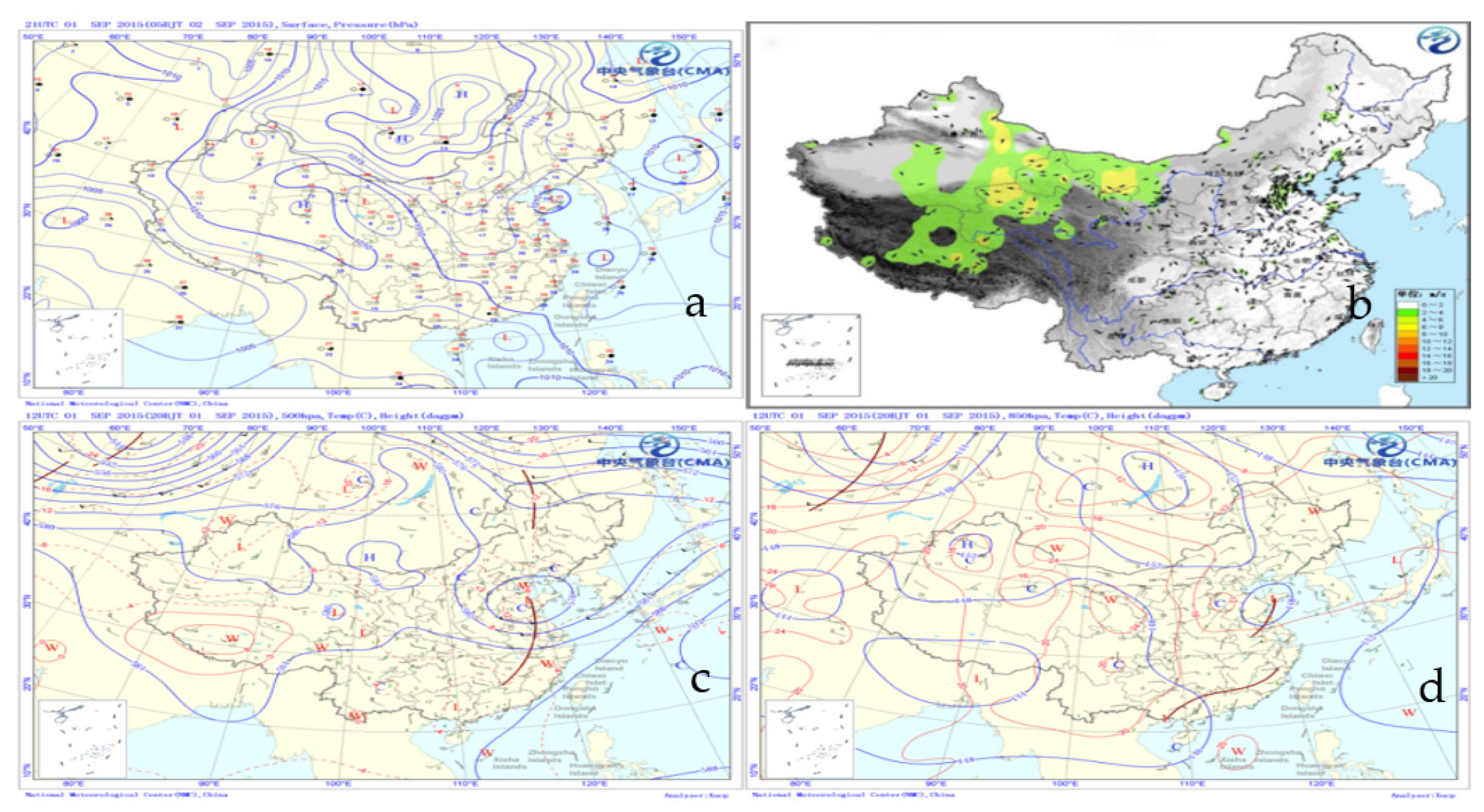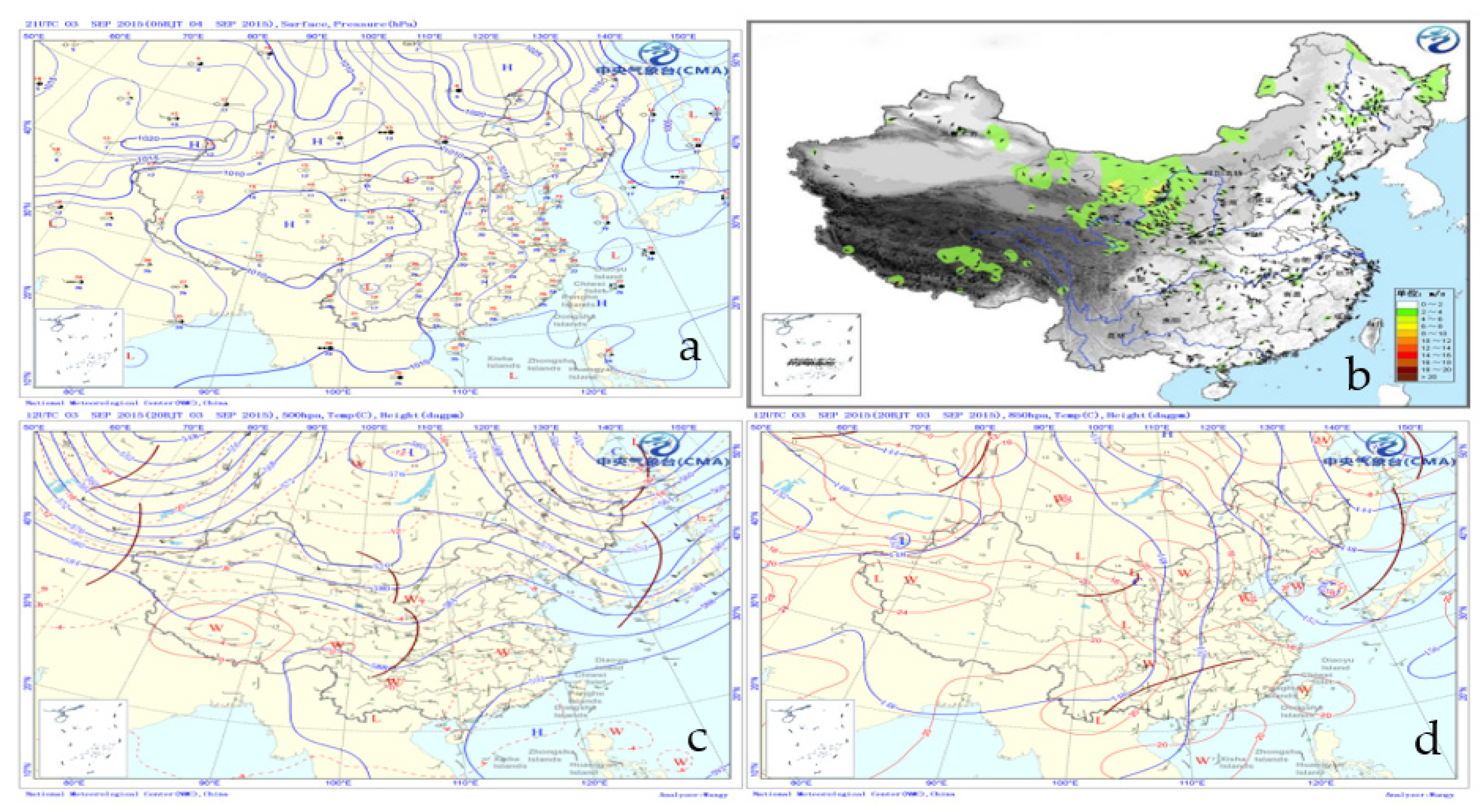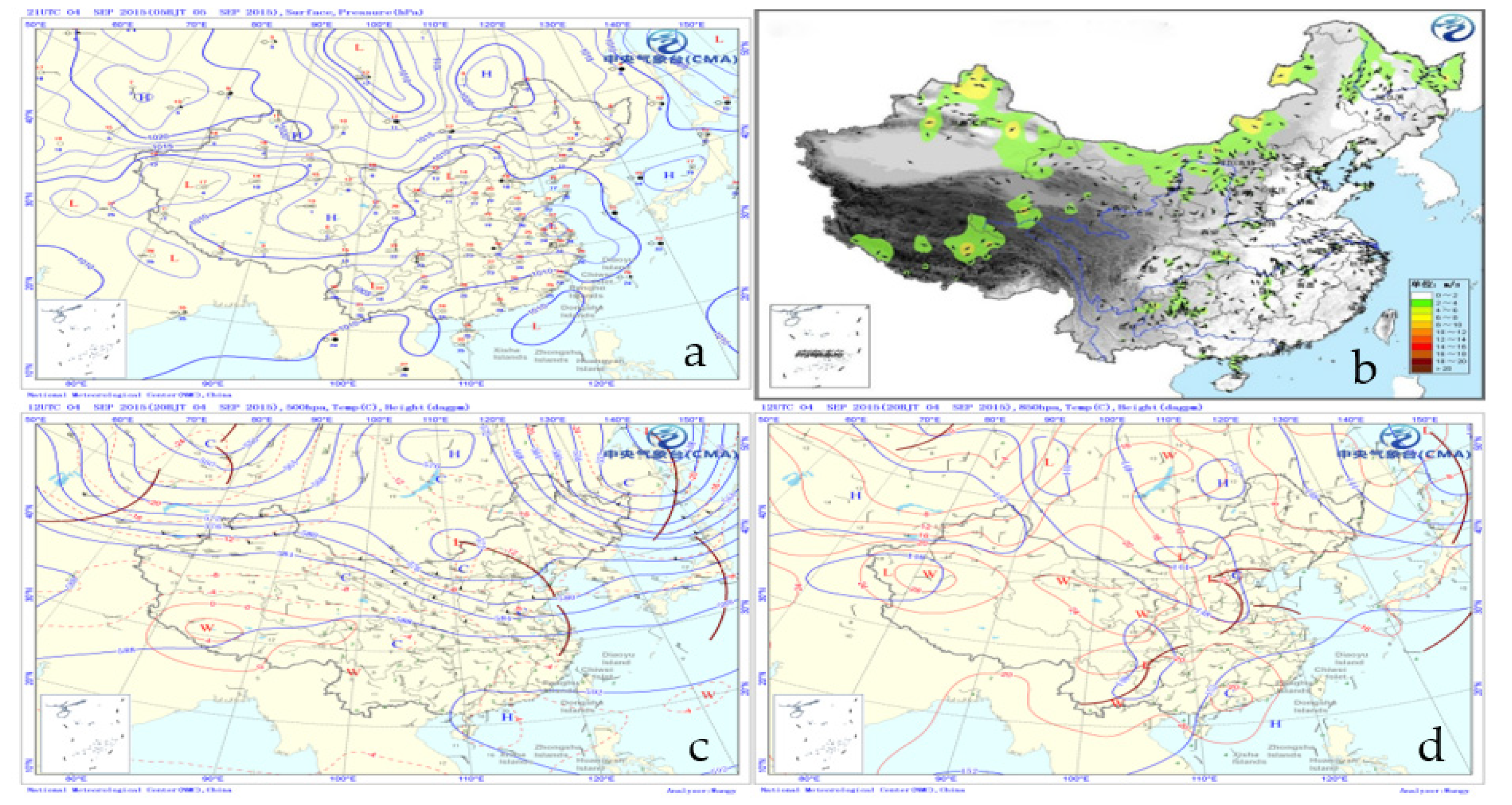Study on Improving the Air Quality with Emission Enhanced Control Measures in Beijing during a National Parade Event
Abstract
:1. Introduction
2. Materials and Methods
2.1. Data
- (1)
- Air-quality data were collected from the data of various pollutants released by the China Environmental Monitoring Station of the Ministry of Environmental Protection (https://air.cnemc.cn:18007/, accessed on 10 May 2022), including the hourly concentration value, daily concentration value, and Air Quality Index (AQI) or various pollutants.
- (2)
- AQI standards and technical regulations in China: air quality standards in China come from the ambient air quality standards (GB 3095-2012) and the technical regulations for ambient air quality index (AQI) (Trial) (HJ 633-2012) (hereinafter referred to as the regulations) issued by the Ministry of Environmental Protection.
- (3)
- The weather situation field three times a day was taken from the weather situation of the Central Meteorological Observatory, including the analysis of the surface situation, the high altitude 850 hPa and 500 hPa situation maps, and the wind direction and speed data observed by the national hourly ground automatic stations.
- (4)
- For the sake of comparing the impact of the enhanced control and emission-reduction measures on air quality, the monitoring station of the Olympic Sports Center was selected as the research object, and the point of time that was picked was 15 days before, during, and after the implementation of the enhanced control and emission-reduction measures, respectively (from 5 August to 18 September, a total of 45 days). Figure 1 shows the location diagram of the research site. The Olympic Sports Center was the emptiest area near the North Fourth Ring Road. The monitoring site was laid in the willows on the south side of the vacant lot. It was about 150 m away from the Olympic Sports Center to the south, 380 m away from the Ding Road to the east, 540 m away from the main road of the North Fourth Ring Road, and 730 m away from Bei Chen Road to the west. There was a large area of open greenbelt in the south of the Olympic Sports Center.
- (5)
- Emission-reduction measures from the government sites of Beijing and its surrounding area during the 2015 Military Parade.
2.2. Methods
3. Results
3.1. Review of the Implementation of Enhance Control and Emission-Reduction Measures during the Military Parade
3.2. Air Quality and Weather Background during the Military Military Parade
3.2.1. Hourly Concentration of PM2.5
3.2.2. Weather Background during the Military Parade
3.3. Comparative Analysis of Beijing’s Air Quality before, during, and after the IECERM for the Military Parade
3.4. Evolution Analysis of Air Quality during the Same Period of Military Parade from 2013 to 2015
4. Conclusions
Author Contributions
Funding
Institutional Review Board Statement
Informed Consent Statement
Data Availability Statement
Acknowledgments
Conflicts of Interest
References
- Li, L.; Liu, Q.; Li, B. Assessment of air quality benefits from control measures during Nanjing Youth Olympic Games. Res. Environ. Sci. 2016, 29, 175–182. [Google Scholar]
- Wang, H.; Li, Y.; Gao, J.; Wang, S.L.; Chai, F.H.; Wei, J.L. Characteristics of air pollution and evaluation of the effects of air quality assurance measures in Shijiazhuang City during the 2014 APEC Meeting. Res. Environ. Sci. 2016, 29, 164–174. [Google Scholar] [CrossRef] [PubMed] [Green Version]
- Lee, B.K.; Jun, N.Y.; Lee, H.K. Analysis of impacts on urban air quality by restricting the operation of passenger vehicles during Asian Game events in BUSAN, Korea. Atmos. Environ. 2005, 39, 2323–2338. [Google Scholar] [CrossRef]
- Beig, G.; Chate, D.M.; Ghude, S.D.; Mahajan, A.S.; Srinivas, R.; Ali, K.; Sahu, S.K.; Parkhi, N.; Surendran, D.; Trimbake, H.R. Quantifying the effect of air quality control measures during the 2010 commonwealth games at Delhi, India. Atmos. Environ. 2013, 80, 455–463. [Google Scholar] [CrossRef]
- Liu, H.; Wang, X.; Zhang, J.; He, K.; Wu, Y.; Xu, J. Emission controls and changes in air quality in Guangzhou during the Asian Games. Atmos. Environ. 2013, 76, 81–93. [Google Scholar] [CrossRef]
- Li, W.T.; Gao, Q.X.; Liu, J.R.; Li, L.; Gao, W.K.; Su, B.D. Comparative analysis of air quality improvement in Beijing during APEC. Res. Environ. Sci. 2015, 12, 0250–3301. [Google Scholar]
- Zheng, J.; Zhong, L.; Wang, T.; Louie, P.K.; Li, Z. Ground-level ozone in the Pearl River Delta region: Analysis of data from a recently established regional air quality monitoring network. Atmos. Environ. 2010, 44, 814–823. [Google Scholar] [CrossRef]
- Xu, X.D.; Zhou, X.J.; Shi, X.H. Spatial structure and scale characteristics of air pollution impacts in urban communities. Chin. Sci. Bull. Ser. D 2006, 35, 1–19. [Google Scholar]
- Li, L.J.; Wang, Y.; Zhang, Q. Effect of wheat straw incineration on air quality in Beijing. Chin. Sci. Bull. Ser. D 2008, 38, 232–242. [Google Scholar]
- Meng, X.Y.; Yu, Y.; Zhang, Z.F.; Li, G.; Wang, S.; Du, L. Preliminary study on the causes of frequent strong haze in January 2013 in Beijing-Tianjin-Hebei region. Environ. Sci. Technol. 2014, 37, 190–194. [Google Scholar]
- Zheng, M.; Salmon, L.G.; Schauer, J.J.; Zeng, L.; Kiang, C.S.; Zhang, Y.; Cass, G.R. Seasonal trends in PM2.5 source contributions in Beijing, China. Atmos. Environ. 2005, 39, 3967–3976. [Google Scholar] [CrossRef]
- Zhang, J.; Lu, Y.; Gui, H.; Liu, J.; Du, P.; Li, D.; Wang, J. Variations of PM2.5 pollution and related meteorological factors before and after the 2014 APEC conference in Beijing. Res. Environ. Sci. 2016, 29, 646–653. [Google Scholar]
- Li, T.Y.; Deng, X.J.; Fan, S.J.; Wu, D.; Li, F.; Deng, T.; Tan, H.B.; Jiang, D.H. Analysis of air quality and pollution meteorological conditions during Guangzhou Asian Games in 2010. Environ. Sci. 2012, 33, 2932–2938. [Google Scholar]
- Yu, Y.Y.; Xie, F.J.; Lu, X.B.; Zhu, Z.F.; Shu, Y. Analysis on the air quality and its cause of Nanjing Asian Youth Conference. Environ. Monit. 2014, 6, 5–9. [Google Scholar]
- Chen, M.; Ma, L.M.; Wei, H.P.; Shi, H.; Ma, J.H.; Zhou, G.Q.; Gu, S.Q.; Zhang, G.L. Effects of meteorological conditions on air quality during World Expo in Shanghai. J. Appl. Meteorol. Sci. 2013, 24, 140–150. [Google Scholar] [CrossRef] [Green Version]
- Zhang, X.Y.; Sun, J.Y.; Wang, Y.Q.; Li, W.J.; Zhang, Q.; Wang, W.G.; Quan, J.N.; Cao, G.L.; Wang, J.Z.; Yang, Y.Q.; et al. Reflections on the causes and control of haze in China. Chin. Sci. Bull. 2013, 58, 1178–1187. [Google Scholar]
- Guo, X.R.; Cheng, S.Y.; Chen, D.S.; Zhou, Y.; Wang, H.Y. Estimation of economic costs of particulate air pollution from road transport in China. Atmos. Environ. 2010, 44, 3369–3377. [Google Scholar] [CrossRef]
- Cao, W.H.; Liang, X.D.; Li, Q.C. Analysis of stage characteristics and influencing factors of a persistent haze process in Beijing. Acta Meteorol. Sin. 2013, 71, 940–951. [Google Scholar]
- Wang, H.L.; Chen, C.H.; Huang, H.Y.; Wang, Q.; Chen, Y.R.; Huang, C.; Li, L.; Zhang, G.F.; Chen, M.H.; Lou, X.R.; et al. Study on emission intensity and pollution sources of volatile organic compounds in Shanghai during World Expo. Environ. Sci. 2012, 33, 4151–4158. [Google Scholar]
- Wu, D.; Liao, B.T.; Wu, X.; Chen, H.Z.; Li, F.; Li, H.Y.; Ai, H. Analysis of haze Weather during Guangzhou Asian Games in 2010. Acta Sci. Circumstantiae 2012, 32, 521–527. [Google Scholar]
- Wang, X.; Westerdahl, D.; Chen, L.C.; Wu, Y.; Hao, J.; Pan, X.; Guo, X.; Zhang, K.M. Evaluating the air quality impacts of the 2008 Beijing Olympic Games: On-road emission factors and black carbon profiles. Atmos. Environ. 2009, 43, 4535–4543. [Google Scholar] [CrossRef]
- Wang, Y.; Hao, J.; McElroy, M.B.; Munger, J.W.; Ma, H.; Chen, D.; Nielsen, C.P. Air quality during the 2008 Beijing Olympics: Effectiveness of emission restrictions. Atmos. Chem. Phys. 2009, 9, 5237–5251. [Google Scholar] [CrossRef] [Green Version]
- Wang, W.; Wang, Y.; Wang, L.; Zhu, B.; Wang, Y. Observation and Study on the air quality at the Olympic Village Station during the Beijing Olympic Games. Res. Environ. Sci. 2010, 23, 48–54. [Google Scholar]
- Hu, J.; Cheng, S.Y.; Su, F.Q. Evolution Characteristics and Causes of PM10 Mass Concentration in Beijing During the Olympic Games and Paralympic Games Period. Res. Environ. Sci. 2009, 22, 1395–1402. [Google Scholar]
- Querol, X.; Alastuey, A.; Ruiz, C.R.; Artiñano, B.; Hansson, H.C.; Harrison, R.M.; Buringh, E.T.; Ten Brink, H.M.; Lutz, M.; Bruckmann, P.; et al. Speciation and origin of PM10 and PM2.5 in selected European cities. Atmos. Environ. 2004, 38, 6547–6555. [Google Scholar] [CrossRef]
- Wu, Q.M.; Zhang, S.J. Analysis of pollution influence factors in a haze weather process. J. Meteorol. Environ. 2010, 33, 12–16. [Google Scholar]
- Li, J.; Wang, Z.; Zhuang, G.; Luo, G.; Sun, Y.; Wang, Q. Mixing of Asian mineral dust with anthropogenic pollutants over East Asia: A model case study of a super-dust storm in March 2010. Atmos. Chem. Phys. 2012, 12, 7591–7607. [Google Scholar] [CrossRef] [Green Version]
- Yu, H.; Wang, P.C.; Zong, X.M.; Li, X.; Lv, D.R. Satellite monitoring of NO2 column concentration in Beijing during the Olympic Games. Chin. Sci. Bull. 2009, 54, 299–304. [Google Scholar]
- Cheng, N.L.; Zhang, D.W.; Li, Y.T.; Chen, T.; Sun, F.; Li, L.; Cheng, B. Characteristics of NOx concentration in Beijing during Athletics Championships and Military Parade in 2015. J. Univ. Chin. Acad. Sci. 2016, 6, 2095–6134. [Google Scholar]
- Wang, W.; Li, J.; Zhu, L.L. Simulation Analysis of Pollutant Emission Reduction Contribution in Beijing-Tianjin-Hebei Region and Surrounding Areas during the Military Parade on Sep 3th; Springer Science & Business Media: Berlin/Heidelberg, Germany, 2008. [Google Scholar]








| Sunday | Monday | Tuesday | Wednesday | Thursday | Friday | Saturday |
|---|---|---|---|---|---|---|
| None traffic restriction 1 August | ||||||
| None traffic restriction 2nd | 5 and 0 traffic restriction 3rd | 1 and 8 traffic restriction 4th | 2 and 7 traffic restriction 5th | 3 and 6 traffic restriction 6th | 4 and 0 traffic restriction 7th | None traffic restriction 8th |
| None traffic restriction 9th | 5 and 0 traffic restriction 10th | 1 and 8 traffic restriction 11th | 2 and 7 traffic restriction 12th | 3 and 6 traffic restriction 13th | 4 and 0 traffic restriction 14th | None traffic restriction 15th |
| None traffic restriction 16th | 5 and 0 traffic restriction 17th | 1 and 8 traffic restriction 18th | 2 and 7 traffic restriction 19th | Double number trave 20th | Single number travel 21st | Double number travel 22nd |
| Single number travel 23rd | Double number travel 24th | Single number travel 25th | Double number travel 26th | Single number travel 27th | Double number travel 28th | Single number travel 29th |
| Double number travel 30th | Single number travel 31st | Single number travel Sep.1st | Double number travel 2nd | Single number travel 3rd Holiday | 4 and 0 traffic restriction 4th Holiday | None traffic restriction 5th Holiday |
| None traffic restriction 6th Working | 5 and 0 traffic restriction 7th | 1 and 8 traffic restriction 8th | 2 and 7 traffic restriction 9th | 3 and 6 traffic restriction 10th | 4 and 0 traffic restriction 11th | None traffic restriction 12th |
| Various Pollutants Concentration (μg·m−3) | Before the Implementation | During the Implementation | After the Implementation | Changes of before and during Implementation (%) | Changes in during and after Implementation (%) |
|---|---|---|---|---|---|
| PM2.5 | 66 | 18 | 52 | 72.73 | 65.38 |
| PM10 | 109 | 34 | 80 | 68.81 | 57.5 |
| NO2 | 49 | 29 | 60 | 40.82 | 51.67 |
| SO2 | 6 | 2 | 5 | 66.67 | 60 |
| O3 | 113 | 79 | 72 | 30.09 | −9.72 |
| Data | Effective Sample | AQI Annual Average | AQI Average during the Military Parade |
|---|---|---|---|
| 2013 | 344 | 88.20 | 58.20 |
| 2014 | 362 | 90.53 | 71.06 |
| 2015 | 360 | 83.75 | 19.27 |
| Three-year average | 355 | 87.49 | 49.51 |
| Before, during, and after IECERM AQI | 2013 | 2014 | 2015 | |||
|---|---|---|---|---|---|---|
| Effective Sample | Average | Effective Sample | Average | Effective Sample | Average | |
| <35 | 11 | 21.19 | 12 | 23.50 | 23 | 16.20 |
| 36–75 | 19 | 56.43 | 19 | 55.79 | 12 | 48.65 |
| 76–115 | 9 | 91.88 | 9 | 91.65 | 6 | 95.78 |
| 116–150 | 5 | 128.60 | 4 | 134.86 | 3 | 124.74 |
| 151–250 | 1 | 163.73 | 1 | 157.38 | ||
| During IECERM AQI | 2013 | 2014 | 2015 | |||
|---|---|---|---|---|---|---|
| Effective Sample | Average | Effective Sample | Average | Effective Sample | Average | |
| <35 | 4 | 21.54 | 5 | 21.52 | 12 | 14.78 |
| 36–75 | 7 | 53.56 | 3 | 60.60 | 3 | 37.20 |
| 76–115 | 3 | 96.64 | 4 | 94.42 | ||
| 116–150 | 1 | 121.92 | 3 | 132.96 | ||
| 151–250 | ||||||
Publisher’s Note: MDPI stays neutral with regard to jurisdictional claims in published maps and institutional affiliations. |
© 2022 by the authors. Licensee MDPI, Basel, Switzerland. This article is an open access article distributed under the terms and conditions of the Creative Commons Attribution (CC BY) license (https://creativecommons.org/licenses/by/4.0/).
Share and Cite
Huang, B.; Deng, M.; Gao, Q.; Ma, Z.; Chen, M. Study on Improving the Air Quality with Emission Enhanced Control Measures in Beijing during a National Parade Event. Atmosphere 2022, 13, 1019. https://doi.org/10.3390/atmos13071019
Huang B, Deng M, Gao Q, Ma Z, Chen M. Study on Improving the Air Quality with Emission Enhanced Control Measures in Beijing during a National Parade Event. Atmosphere. 2022; 13(7):1019. https://doi.org/10.3390/atmos13071019
Chicago/Turabian StyleHuang, Bingbo, Minjun Deng, Qingxian Gao, Zhanyun Ma, and Mindong Chen. 2022. "Study on Improving the Air Quality with Emission Enhanced Control Measures in Beijing during a National Parade Event" Atmosphere 13, no. 7: 1019. https://doi.org/10.3390/atmos13071019
APA StyleHuang, B., Deng, M., Gao, Q., Ma, Z., & Chen, M. (2022). Study on Improving the Air Quality with Emission Enhanced Control Measures in Beijing during a National Parade Event. Atmosphere, 13(7), 1019. https://doi.org/10.3390/atmos13071019






